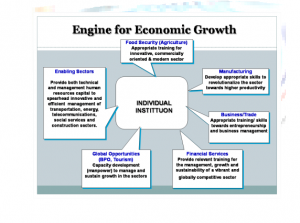This is one of the generic strategies by Michael porter. This is organizations doing everything to achieve a CA through producing products or services at a lower unit cost (lowering cost structure) – charge a lower price. Increase efficiency and lower costs – the
manufacturing and materials management functions are the center of attention. A low level of product differentiation, it means that you do not want to be the industry leader in differentiation. Target the average customer Scale and Focus, not Product Variety.
Ignores the different market segments and focuses on mass market.
Generally, cost leadership is about being the lowest cost producer in the industry. For an organization to gain competitive advantage, it must achieve overall cost leadership in an industry it is competing in. For companies competing in a ―price-sensitive‖ market, cost
leadership is the strategic imperative of the entire organization. It is vitally important for these companies to have a thorough comprehension of their costs and cost drivers in order to pursue a cost leadership strategy. They also need to fully understand their
targeted customer group‘s definition of quality, usually denoted in terms of design specifications, contractual requirements, delivery and services at the lowest possible cost. Of particular importance will be for the company to attain a cost level that is low relative
to its competitors.
Advantages
- charge a lower price yet make the same level of profit.
- win in the price war.
- low-cost as an entry barrier.
- protected from rivals.
- less affected by powerful buyers and suppliers.
- room to reduce its price to compete with substitute products.
Disadvantages
- technological advancement makes the low cost advantage outdated.
- imitation ability of competitors.
- lose sight of changes in customers‘ tastes
Cost leadership = aggressively seeks efficient facilities, pursues cost reductions, and uses tight cost controls to produce products more efficiently than competitors. Cost leadership does not only benefit the individual institution but also helps grow the economy because
economic activities are multiplied. For example a few sectors in Kenya Economy towards achieving Vision 2030 as shown
below:-
